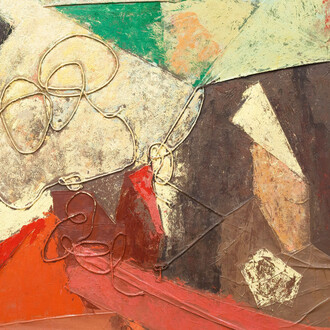Halsey McKay is honored to present Visible World, an installation of contemporary painting, featuring the work of Graham Collins, Cynthia Daignault, Xylor Jane, Matt Kenny, Dylan Vandenhoeck, and Kemar Keanu Wynter.
These six artists work in and around various traditions of painting to confound conventional notions of what happens when we look at a painting. Sometimes a painting’s function is to convey and contain worlds though images, and other times a painting may confront its viewer in real time. The same painting can do both things, often simultaneously. With distinct strategic approaches to painterly facture, the paintings in Visible World tease apart painting’s ability to hold representational and optical truths.
A certain kind of person is fond of referencing Picasso saying it took a lifetime to paint like a child. More compelling perhaps is the space between that concept and the sort of disinterested vision that philosophers like Kant grasped at: can we see like a child, but with the knowledge of an adult? There are as many kinds of adults as there are adult people, so mapping this possibility becomes a fraught task.
Regarding art specifically we are burdened by the conflicting rhetorical demands of structuralism, pluralism, identity politics, and the social and economic demands of mediated modern life. By breaking the fourth wall of painting’s isms, movements and genres, the artists in Visible World offer an extrapanopticonic visuality of observed reality that can hopefully serve as antidote to digitally manipulated attention spans.
Kemar Keanu Wynter’s recent paintings on collaged cardstock supports, punctured sporadically with metal grommets, are covered in densely layered oil pastel, acrylic and graphite laid down in four distinct sections on each hexagonal surface. Conceived as a palimspestic herald within the overall form of a food storage container, these works follow a strict structural format to encode abstract, expressionistic space with a specific, individual language of sign.
Dylan Vandenhoeck works in the mode of a traditional plein-air painter with the distinct temporal visuality of the 21st century. Painted on site, these paintings are not content to rest easily on their ostensible subjects and may capture the image of a place, but also the time passed looking at it, peripheral glances side to side, detritus at the artist’s feet and his body itself. Each painting depicts the full corporeal context of a visual encounter with the world.
If the rectangular format of a painting signals to its viewer that they are looking into a fictive space authored by the painter, Matt Kenny’s tubes look back at us. Always in pairs, sensitively rendered in a mean oil on metal support, and borne of a paranoid political desperation, the tubes recall binocular vision, surveillance and drain pipes, reminding us that we can’t really look through a painting.
Across millennia, people have looked to pattern and mathematics as guides to revealing mystic truths. Xylor Jane’s paintings follow precise, esoteric systems to create complex, vibrating fields of color, text, numbers and shape, consolidated on a singular surface. Her detailed marks harmonize into rich keys to make sense of the world as much as they synthesize powerful formal abstractions.
Cynthia Daignault’s expansive painting practice unites historical research, travel, taxonomy and memory. Often comprising multiple painted panels that vacillate between landmark phenomena and the incidentally observed, Daignault’s vision of a site includes its psychosocial makeup, and embraces monumentality within the banal. Daignault uses observational painting as a foil, a mediating tool, and a conceptual framework to engage with art history, narrative, social issues, activism, and time-based media.
Grounded by simple, painted canvas faces, Graham Collins’ works are each preceded by handmade ceramic forms which support the picture plane. Initially appearing as minimalist painting objects, the specific material properties and technical knowledge that go into producing his paintings are foregrounded conceptually while being physically obscured or hidden from view. Unlike traditional ceramics or painting, most of the expressive content and physical labor goes into the support and reveals itself only to an especially curious observer or sustained viewing, where the austere facade gives way to handmade, intuitive and expressionistic formal logics.













